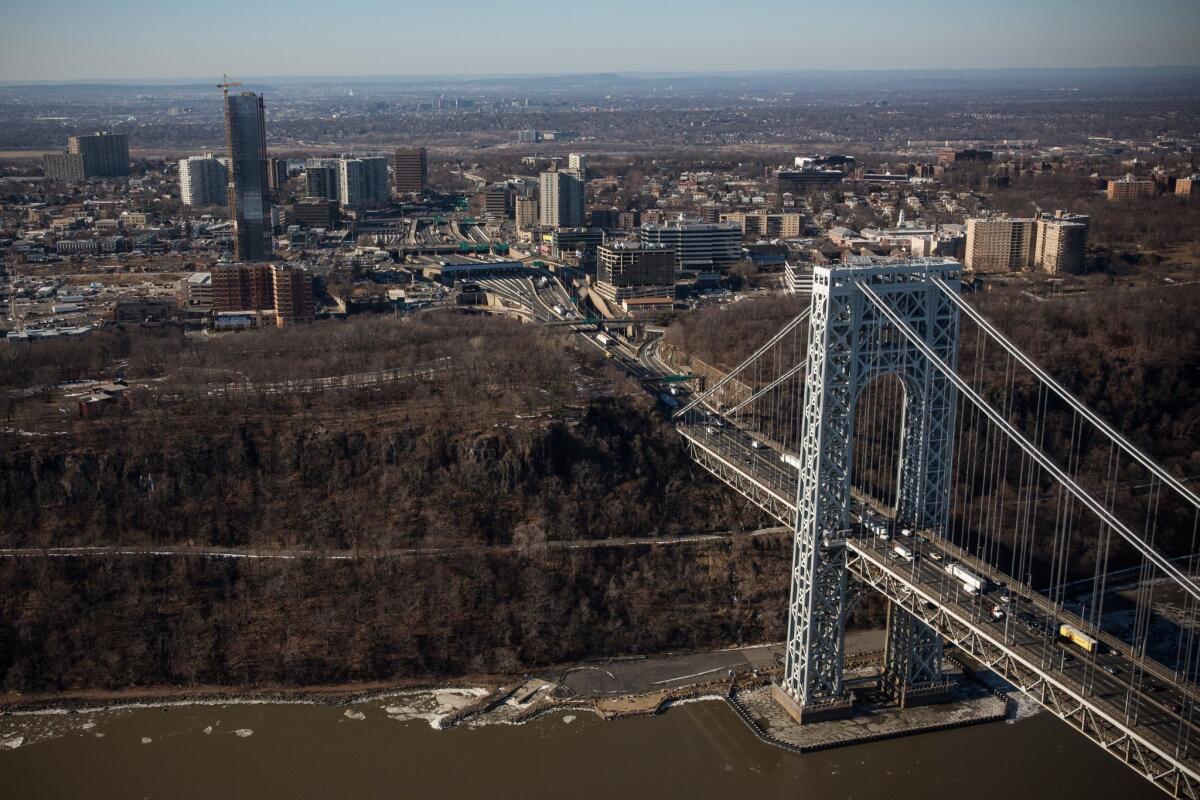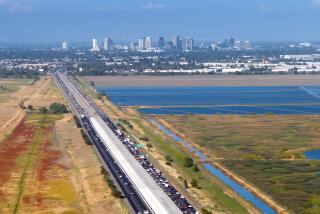Bridge emails show Chris Christie aides ignored public safety

- Share via
Port Authority officials appointed by Gov. Chris Christie knew that the closures they engineered on lanes leading to the George Washington Bridge in September were causing serious delays for emergency responders but still ordered the closures to continue, documents released Friday show.
The documents, more than a thousand pages of emails and texts between Port Authority officials and staff, curious reporters and Christie staffers, did not clarify what the New Jersey governor knew about the lane closures, which he said were engineered by his staff without his knowledge, apparently as retribution to the Fort Lee mayor, who had failed to endorse his reelection campaign. But they did suggest that Port Authority officials blatantly ignored protests from staffers and constituents.
An email from a Port Authority staffer to David Wildstein and Bill Baroni, Christie’s Port Authority appointees, on the evening of Monday, Sept. 9 -- the first day of the closures -- indicated that EMS workers had trouble responding that day to an incident involving a missing child (later found) and a cardiac arrest.
Still, Wildstein ordered that the blockages continue on Tuesday, according to emails between Cedrick Fulton, the Port Authority’s director of tunnels, bridges and terminals, and Robert Durando, manager of the George Washington Bridge. Ultimately the roads were closed for four days.
Port Authority staffers knew the closures would cause trouble even before they started. They were told a study was being done because Fort Lee had three dedicated access lanes to the bridge, which blocked access to people coming to the bridge from I-95. The study would assess what would happen if those lanes were used for highway drivers rather than Fort Lee drivers, emails suggest.
“What is driving this?” asked Daniel M. Jacobs, a general manager in the Transportation and Revenue division in the Port Authority, asked in a Sept. 6 email. Gerrard Quelch, a Port Authority supervisor, agreed.
“A single toll lane operation invites potential disaster,” he wrote.
Although Port Authority staff knew the closures would happen, Fort Lee officials have said they did not. That appeared intentional. In emails between Durando and Fulton about the second day of closures, Durando replied that he would tell his staff.
“Just to your staff -- right?” Fulton replied just three minutes later.
The Fort Lee mayor, Mark Sokolich, repeatedly contacted the Port Authority to find out what was going on.
“Please call me as soon as possible in hopes that we can resolve this issue and reverse a policy change that is wreaking havoc on Fort Lee …. the otherwise cooperative and supportive host community to the busiest bridge in the world,” Sokolich wrote in a letter.
The traffic jams resulting from the closures invoked the ire of Patrick Foye, executive director of the Port Authority, who was appointed by New York Gov. Andrew Cuomo. (The two-state agency includes appointments made by both governors.) On the morning of the fourth day of closures, Foye said the decision to close access roads in Fort Lee “violated federal law and the laws of both states.”
“I will get to the bottom of this abusive decision which violates everything this agency stands for; I intend to learn how PA [Port Authority] process was wrongfully subverted and the public interest damaged to say nothing of the credibility of this agency,” Foye wrote.
“This hasty and ill-advised decision has resulted in delays to emergency vehicles. I pray that no life has been lost or trip of a hospital- or hospice-bound patient delayed,” Foye wrote.
Foye’s email appeared to have prompted an effort by his second-in-command, New Jersey appointee Baroni, to pressure Foye to keep quiet.
“Pat we need to discuss prior to any communications,” Baroni wrote to Foye at 8:40 a.m.
“Bill we are going to fix this fiasco,” Foye replied.
“I am on my way to office to discuss. There can be no public discourse,” Baroni wrote.
Several days later, Christie appointees on the authority’s board of commissioners were blaming Foye for a leak to the Wall Street Journal about the lane closures.
Christie appointee Wildstein and Bill Stepien, the governor’s political strategist who was canned Thursday, also corresponded about Foye.
“We need to address leaks from Foye and his messing with us 5 weeks before election,” Wildstein wrote to Stepien.
As reporters began to question why the lanes were closed, the Port Authority stonewalled media, the documents show. Dozens of emails from spokesman Steve Coleman to Wildstein and other staffers detail media requests about the closure, ending with the line, “I will not respond unless instructed to do so.”
“Additional calls from the Star Ledger and Associated Press. I will not respond to either call,” he wrote Oct. 7.
Christie press secretary Michael Drewniak got pulled into crisis response as media began to ask more questions about the story in October and November. He and Wildstein corresponded through their Gmail accounts about various reporters and about Foye.
Wildstein used his Port Authority email to forward work emails to his Gmail account, where he apparently thought he could speak more freely. Wildstein wrote to Drewniak that he had issues with a query from a reporter forwarded by Patrick Foye that said Wildstein was in Fort Lee “directing” the lane closures. “DIRECTING lane closures would be grossly inaccurate. Foye is a piece of crap,” he wrote.
The documents also contain the traffic study that was allegedly conducted during the lane closure, and which Christie said for weeks was the cause of the traffic jam. Plans for the study appeared to begin Aug. 28, two weeks after Christie’s deputy chief of staff Bridget Anne Kelly wrote to Wildstein, “Time for some traffic problems in Fort Lee.” On Aug. 21, Wildstein wrote to Durando in an email, “May I see you for a few minutes after this meeting?” The two spoke, although the emails do not disclose the topic.
Port Authority staff sent Wildstein a “suggested modification” to change the lane access from Fort Lee, “as requested.” A handful of Port Authority staff were pulled into the project to ensure the lane closures occurred and to measure traffic time in Fort Lee and on Interstate 95.
A report, “Reallocation of Toll Lanes at the GWB: an EARLY assessment of the benefits of the trial” was issued Sept 12, at the end of the week of the closures. The six-page document explained that lanes 20, 22 and 24 had been dedicated to local traffic from Fort Lee, and that eliminating those lanes caused a queue of 260 vehicles stretching half a mile in Fort Lee.
“Local traffic is experiencing an additional 2,800 vehicle hours of delay,” the study said.
The trial saved time for “mainline” traffic, the report suggests, but that worked out to a loss of money in toll booths because people were sitting in traffic for so long they paid off-peak toll rates, rather than peak toll rates.
On the last page, under the header “Conclusions,” the report only says “TBD.”
Twitter: @alanasemuels
Twitter: @ByBrianBennett
More to Read
Get the L.A. Times Politics newsletter
Deeply reported insights into legislation, politics and policy from Sacramento, Washington and beyond. In your inbox three times per week.
You may occasionally receive promotional content from the Los Angeles Times.












